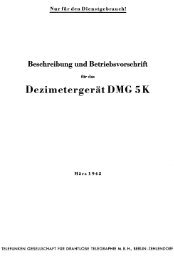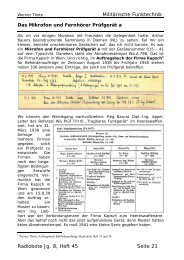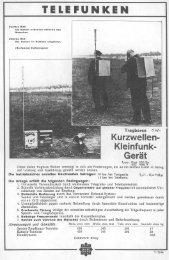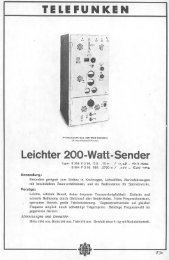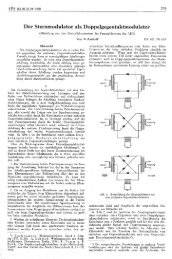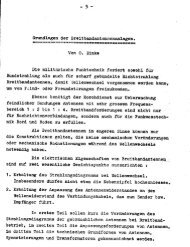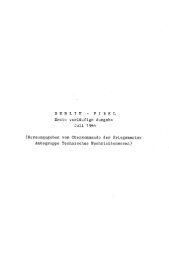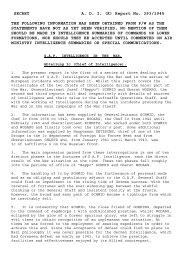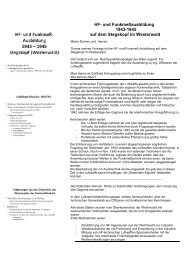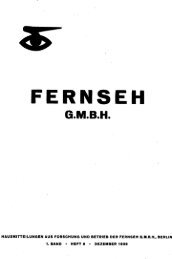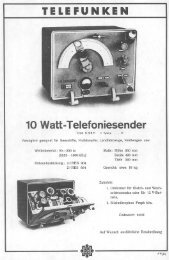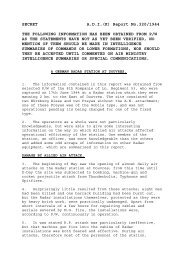SECRET A. D. I. (K) Report No. 357/1945. THE ... - Cdvandt.org
SECRET A. D. I. (K) Report No. 357/1945. THE ... - Cdvandt.org
SECRET A. D. I. (K) Report No. 357/1945. THE ... - Cdvandt.org
You also want an ePaper? Increase the reach of your titles
YUMPU automatically turns print PDFs into web optimized ePapers that Google loves.
63. The beacon recognition is given by means of a self-evident code name for example,<br />
"Berolina” for Berlin – which is spoken by the voice in place of 000°.<br />
64. The airborne equipment is the FuGe 125 consisting of the E.B.L.3 with the Tzg<br />
(Telephoniezusatzgerät) which enables the 30.0 - 33.3 mc/s transmission picked up on the<br />
E.B.L.3 receiver to be heard in the pilot's headphones. Though the Hermine beacons were fully<br />
operational there was a scarcity of FuGe 125 sets, as a result of which practical experience of<br />
this system was too limited to judge of its efficiency or to lead to further improved tactical<br />
requirements been formulated.<br />
PULSE SYSTEM.<br />
Ingolstadt<br />
65. All the P/W had heard reference to Ingolstadt and agreed that it was a long-range<br />
navigational system.<br />
66. One P/W thought that Ingolstadt was the cover name for a pulse navigation system using<br />
hyperbolic curves and similar to British Gee; it was originated by Telefunken in 1938 but was<br />
then turned down by the R.L.M. In his recollection the original Telefunken idea derived from<br />
theoretical discussions at an international conference before the war.<br />
67. As mentioned earlier under the heading of Komet, Professor von HANDEL maintained that<br />
owing to the incidence of mutual interference between direct and reflected waves the system<br />
was impracticable at long range. In consequence of von HANDEL’s view the system was<br />
dropped.<br />
68. Much consternation and annoyance was occasioned in 1944, when it was found that the<br />
Allies were successfully operating a similar system.<br />
69. Truhe is the cover name used to describe navigational aid system, using ground stations,<br />
similar to those of British Gee. In effect the British Gee stations were also used, the airborne<br />
sets being almost identical with the British Gee boxes.<br />
Truhe.<br />
70. There is no very distinct difference between "Truhe" and "Hyperbel". The latter term was<br />
originally coined to denote our Gee. It was also used when German aircraft equipped with<br />
British Gee sets made use of British ground stations.<br />
71. The British Gee chain was used successfully but it was realised that so soon as the<br />
Germans lost an aircraft, over England, a change would be made. The German "Y" service<br />
monitored the British ground stations to follow any change in Gee phasing and passed advice of<br />
such change to their aircraft by W/T.<br />
72. Truhe referred to the German system which was ultimately to cover the 20 to 100 mc/s<br />
band and employed various types of ground transmitters including Feuerhilfe, Feuerstein,<br />
Feuerzange and Feuerland. All these transmitters could also be used to jam our own Gee,<br />
further details of which will appear in a subsequent report on German Radio Countermeasures.



